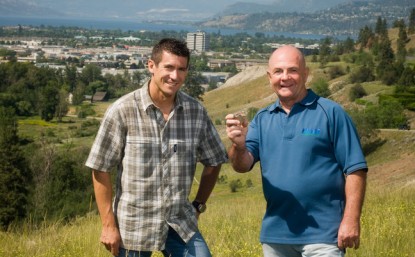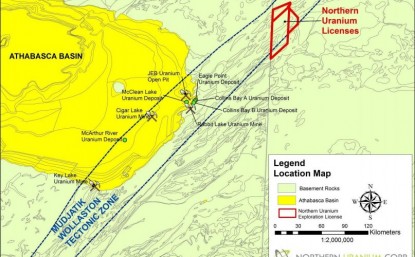
Chad Ulansky cut his teeth on Ekati, Canada’s first diamond discovery, but it’s uranium that he’s hunting for now in Canada’s frozen North.
The Kelowna geologist is president and CEO of Northern Uranium (TSXV:UNO), which is exploring in northwestern Manitoba just beyond the eastern edge of the prolific Athabasca Basin.
Ulansky got his start as a geologist with Chuck Fipke’s Dia Met Minerals, which discovered Ekati, Canada’s first diamond mine, at Lac de Gras in 1991. The discovery by Fipke and Dia Met partner Stu Blusson, which came after years of systematic exploration, rocked the global diamond industry and sparked the biggest staking rush since the discovery of gold in the Klondike.
The Ekati discovery also kick-started the Canadian diamond industry and upset the De Beers cartel. Canada is now the world’s third largest producer of diamonds by value, with four mines and another two under construction.
Last year, Fipke sold his 10% interest in Ekati for $67 million US to Dominion Diamond Corp., which owns 89% of the mine (Blusson retains a 10% interest).
The Fipke-Ulansky partnership began when Ulansky was just a teenager. An avid outdoorsman from a young age, Ulansky met Fipke when the geologist attended a presentation Ulansky gave to a Kelowna scout troop, and the two hit it off. Fipke told him he would call him at the end of the school year.
Sure enough, Fipke phoned in June and offered Ulansky a summer job, a gig that turned into a continuing, decades-long partnership.
Ulansky continued working for Dia Met until its purchase by BHP in 2001.
Along the way, he obtained a bachelor’s degree in geology at the University of Cape Town in South Africa, where he studied under renowned diamond geologist Dr. John Gurney.
Ulansky retained his love of the outdoors while living in Cape Town. In 2001, he set a record for the Three Peaks Challenge, a 50-km mountain running trail that involves ascents of the three major peaks above Cape Town — Devil’s Peak, Table Mountain and Lion’s Head.
URANIUM HUNT
He’s climbing a peak of a different sort as president and CEO of Northern Uranium, which is searching for an economic uranium deposit just outside the Athabasca Basin — home to dozens of competitors.
Northern Uranium has earned a 50% option on the Maguire Lake property from CanAlaska Uranium. The property borders on Saskatchewan and is located along the extension of the Mudjatik Wollaston tectonic zone, which runs southwest-northeast near the Manitoba border. The zone hosts many of the Basin’s major uranium deposits, including Cameco’s Cigar Lake, McArthur River and Key Lake.

Cigar Lake and McArthur River both have uranium grades above 20%, and Ulansky is out to prove that high-grade uranium exists on Northern Uranium’s property as well.
His thesis is that extensive glaciation stripped off the sandstone and sediments and left basement rock exposed, hosting shallow uranium mineralization.
There is some early evidence supporting his thesis. Prospecting work done by CanAlaska uncovered a boulder that contained 66% uranium oxide, and in situ grab samples have contained grades up to 9% U308.
Finding dozens of mineralized boulders in a small area is highly uncommon, Ulansky says, and Northern Uranium is now searching for the bedrock source of that mineralization.
“What we need geologically is all that uranium in trace quantities across huge volumes of rocks to be picked up and brought to one spot and concentrated there,” Ulansky says, talking about geological changes that occur over millions of years. “The mechanism for that is percolating fluids, waters that circulate through bedrock. When these fluids are slightly oxidizing, they scavenge uranium, they move thru cracks, fissures and preferentially strip out the uranium and carry it with them. The fluids migrate through rocks, when they get to a fault zone that’s permeable, they’ll rise to the surface and cool. Solubility drops and over millions of years, fluids will circulate and uranium will start to precipitate out.”
Northern Uranium has expanded on CanAlaska’s program using various methods — including electromagnetic, magnetic, ground gravity and radon surveys — to narrow down drill targets for a “focused” $1.5-million exploration program.
Airborne magnetics has identified faults that could provide an important pathway for mineralizing fluids, while electromagnetics has identified a 35-kilometre conductor path where precipitation of uranium mineralization is more likely.
RADON RESULTS STELLAR
Radon surveys — which are not being used by all early-stage uranium explorers in the Basin — are among the most useful tools in the hunt for uranium mineralization, Ulansky says.
Just as Fipke used diamond indicator minerals to find Ekati, Northern Uranium is using radon surveys to detect the presence of uranium mineralization.
“The silver bullet for uranium is radon. It’s a gas, highly mobile, very short half-life, that percolates up from uranium mineralization at depth,” Ulansky says.
“Imagine if you were exploring for gold and it uniquely gave off something called gold gas. You’d just go look for the gold gas.”
Radonex, the same company that completed radon surveys for Fission’s high-grade Patterson Lake South project did lake-based radon work for Northern Uranium, and the results were comparable to PLS’s, Ulansky says. Results from the land-based radon surveys were also strong.
However, the challenging part is that the radon signature is much larger than the uranium mineralization associated with it.
“We are very, very strong believers in the fact that there is high-grade uranium mineralization there, it’s just a matter of figuring out where it is,” Ulansky says. “I firmly believe there’s a major discovery to be found, and it’s just a matter of drill testing to find it.”
Watch: Mr. Fipke’s Canadian Mining Hall of Fame 2013 Induction Video
TARGET ZONE IDENTIFIED
Ulansky’s team has zeroed in on an area 3 kilometres wide by 10 kilometres long, centred over Maguire Lake. The target zone is northeast and up ice of the high-grade boulder discovered by CanAlaska.
“The ice direction is from northeast down to the southwest, so it certainly hasn’t come from the Athabasca, which is down-ice,” Ulansky says. “That’s telling us that up-ice there is some exceptionally rich mineralization to be found.”
During the 3 coldest months of winter, crews have been testing priority targets underneath the lake.
Early drilling has hit some uranium mineralization but not in economic quantities, Ulansky says.
Drill results are expected in the coming months, and with $500,000 in the treasury, Northern Uranium will need to raise money to fund more drilling.
Fipke is a special advisor and major shareholder.
“All the geology to date looks exceptionally promising, it’s just a matter of raising the funds to continue drilling,” Ulansky says.
Northern Uranium can earn up to an 80% interest in the project by spending an additional $8.4 million in two tranches and issuing 7.5 million shares and 3.75 million warrants over four years.
Ulansky remains a key player in Fipke’s group of companies; he’s president of Cantex Mine Development and president and CEO of Metalex Ventures. The two companies share Kelowna office space with Northern Uranium, helping keep the burn rate down to $10,000 a month.
The group of companies also own the drill rigs.
The radon and boulder indicators that Northern Uranium has are promising, but now comes the hard part: finding high-grade uranium mineralization. Ulansky compared the exploration effort to trying to break a plate at the bottom of a swimming pool blindfolded, with a pool cue. You know the plate’s there, but to smash it, you have to find it.
If you’re going for that type of swim, the partners you want are Chad Ulansky and Chuck Fipke.
To receive drilling news directly from the company, email info@northernuranium.com with the subject line, “Please add me to your email list.” That or call the company’s Kelowna office at 1.250.448.4110 for more information.
Author has a financial interest in Northern Uranium. The article is not intended to be investment or professional advice of any kind. Readers are strongly encouraged to independently verify all information contained in the article, as it may contain errors. Please see Terms of Use and Privacy Policy for important disclosures. Some of the statements contained herein may be forward-looking statements which involve known and unknown risks and uncertainties. Without limitation, statements regarding potential mineralization and resources, exploration results, and future plans and objectives of Northern Uranium are forward looking statements that involve various risks. The following are important factors that could cause Northern Uranium’s actual results to differ materially from those expressed or implied by such forward looking statements: changes in the world wide price of mineral commodities, general market conditions, risks inherent in mineral exploration, risks associated with development, construction and mining operations, the uncertainty of future profitability and the uncertainty of access to additional capital. There can be no assurance that forward-looking statements will prove to be accurate as actual results and future events may differ materially from those anticipated in such statements. Northern Uranium undertakes no obligation to update such forward-looking statements if circumstances or management’s estimates or opinions should change. The reader is cautioned not to place undue reliance on such forward-looking statements.



 Follow us on Twitter
Follow us on Twitter Become our facebook fan
Become our facebook fan











Comments are closed.